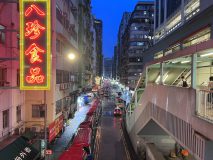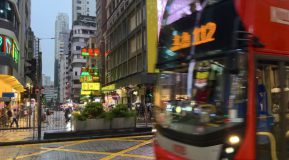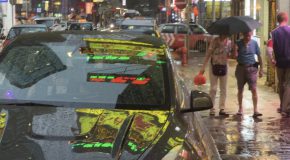Youtube Link: https://youtu.be/lzP5z6pzz0I
Title: The Extinguished City: Fading Neon Signs, Portland Street, Mong Kok; Yau Ma Tei
Video: directed and edited by Song Yiqun
The theme I chose is the fading of neon signs as a phenomenon that reflects the changing urban landscape of Hong Kong in the process of modernization. The field research was conducted in Yau Ma Tei and Portland Street in Mong Kok.
Hong Kong as a global city of commerce and cultural intermingling has emerged neon sign as a symbol with regional cultural characteristics in the development process. The first local neon factory was set up in 1932 in response to the growing demand for neon signs in Hong Kong. In the 1950s, with the rapid growth of Hong Kong’s industry and local economy, the pursuit of neon signs in the catering and entertainment industries led to its frequent appearance in the urban landscape. Hong Kong’s local consciousness gradually awakened in the 1960s, localized designs began to appear on neon signs. When collecting video footage, I started with Portland Street and explored the neon signs that remained in nearby blocks. I found that most of the neon signs here are mainly geometric shapes with simple lines, supplemented by text. The text messages displayed on the signs are very straightforward and clear, serving the nature of the local stores and the community environment. For instance, “Ba Zhen Shi Pin” located near Garden Street in Mong Kok, the words on the sign clearly show the basic information of the store. In addition, neon signs are often a mixture of Western and Chinese languages, cultural icons, design styles and visual colors, resulting in a localized hybrid visual style.

Photograph of “Ba Zhen Shi Pin” located near Garden Street in Mong Kok
Neon signs as a recurring visual symbol significantly increase the clarity and legibility of the cityscape, constructing Hong Kong’s urban identity and relating it to the internal architectural setting. Neon signs are often found on the facades of duplex lofts (Tong Lau) and mixed-use complexes. As a result of the population boom caused by immigration in the 1960s, Hong Kong witnessed a proliferation of buildings including Tong Lau, which utilized a combination of stores on the ground floor and residences on the upper floors. The tension in the use of urban area led merchants to install neon signs in the gaps between buildings and in the protruding balconies. In field shooting I found that most of the neon signs in the Yau Ma Tei and Mong Kok are projecting horizontal signs that extend horizontally from the side of the ground floor of the Tong Lau to the space above the street. This height allows pedestrians to clearly identify the location and business category of the stores. Moreover, the text messages on neon signs tend to have primary and secondary importance, with the size of the letters determining the importance of the information. For example, on a Tong Lau near Portland Street, the store name “Jin Li Gong” occupies the largest layout of the neon sign as major message, and below it, the specific business is indicated in small, bright green letters that distinguish it from the red background.

Photograph of “Jin Li Gong” located near Portland Street in Mong Kok
In fact, with the modernization of Hong Kong, neon signs are gradually disappearing from the cityscape. The reasons for this phenomenon can be summarized as the Buildings Department’s demolition orders and the emergence and replacement of LED. Compared with the traditional neon lights, LED consumes less electricity, has higher light intensity, yet the production cost is lower. From the videos captured, it can be noticed that the number of neon signs in Yau Ma Tei and Mong Kok has been considerably reduced and are mostly replaced by LED signs. It is difficult to distinguish them through appearance. During offline research I discovered that neon signs tend to use vertical linear tubes in their outlook accompanied by flickering and buzzing of the light source, whereas LED signs have a more stable light supply which allows merchants to add intricate designs to it. However, neon signs have a unique social function and emotional reaction as an important cultural marker in Hong Kong’s streetscapes. Words and images on neon signs display information about the human activities that surround the architecture, as well as serving as a venue for displaying the visual language of the urban space. For the community, the removal of neon signs is an erasure of the neighborhood communication and the collective emotional memory that has been formed around these signs.
While writing this essay, I researched for historical background information about the origin, introduction and development of neon signs in Hong Kong. For instance, through reading Vernacular Design: a History of Hong Kong Neon Signs, I learned how neon signs entered and rooted in Hong Kong’s community culture, becoming a cultural hybrid of Western and Chinese characteristics with a sense of local coexistence. Meanwhile, through offline field visits, I realized the fact of gradually disappearance of neon signs in Hong Kong and its connection with the surrounding architecture and community. Corresponding to the video and photographs, I put forward the hypothesis of the source and influence of the fading phenomenon, which is corroborated by secondary research materials. In the video, centered with Dundas Street in Mong Kok, I captured the scene of neon signs and LED signs at an intersection with high pedestrian flow. By filming the buses and the flow of people, I emphasize the fact that neon signs are still hanging in people’s view as an important symbol of Hong Kong’s streetscape after years of time. The entire film is shot in first person view and partly in elevation to recreate the neon signs in Hong Kong’s streetscapes from a tourist’s point of view. I wanted to bring an immersive experience to the viewers through wide shot. Also, to enhance the interactivity of the video, I interspersed zoom shots of specific targets to highlight the focus of the image by enlarging the lens frame.

 Screenshots from the video- Screenshots from the video- Dundas Street in Mong Kok Nathan Road in Mong Kok
Screenshots from the video- Screenshots from the video- Dundas Street in Mong Kok Nathan Road in Mong Kok
To summarize, through this project I argued that neon signs, as an important feature of Hong Kong’s streetscape, are in danger of fading away, and its real-life impact on the surrounding environment and community culture.
Song Yiqun
3036097293
Bibliography:
Broto, V. C. (2015). Socio-technical artefacts and urban stories of energy: Neon and lighting politics in Hong Kong. Unpublished Paper, University College London, London.
Kwok, B. S. H. (2018). Landscape of light: Chinese typography and visual communication on Hong Kong’s neon signs. Hong Kong journal of Social Sciences, (52), 73-97.
Kwok, B. S. H. (2020). The Imageable City–Visual Language of Hong Kong Neon Lights Deconstructed. The Design Journal, 23(4), 535-556.
Kwok, B. S. H. (2021). Vernacular design: A history of Hong Kong neon signs. Journal of Design History, 34(4), 349-366.
Lou, J. J. (2016). Shop sign as monument: The discursive recontextualization of a neon sign. Linguistic Landscape. An International Journal, 2(3), 211-222.
Lam, Y. M. (2024). A study of light pollution discourse in Hong Kong. Visual Studies, 39(1-2), 220-238.
Song, G. (2021). Hybridity and singularity: A study of Hong Kong’s neon signs from the perspective of multimodal translation. The Translator, 27(2), 203-215.
I found this article to be a fascinating exploration of the cultural and architectural significance of neon signs in Hong Kong. One particular point that stood out to me was the way neon signs have been strategically placed on Tong Lau and mixed-use complexes to enhance the clarity and legibility of the cityscape. This placement allowed pedestrians to easily identify the location and nature of the stores, which was especially crucial during the population boom caused by immigration in the 1960s.
I also appreciated the article’s emphasis on the fusion of local and global influences in neon sign design. The blending of Western and Chinese languages, cultural icons, design styles, and visual colors has resulted in a unique hybrid visual style that represents the local stores and community environment. This is a reminder of how cultural exchange and intermingling can lead to the creation of new and exciting forms of expression.
Furthermore, the article’s focus on the fading of neon signs as a reflection of the evolving urban landscape of Hong Kong is poignant. As the city continues to modernize, the disappearance of neon signs serves as a reminder of the changing times and the need to preserve elements of the past while embracing the future. Overall, I found this article to be a thought-provoking and insightful exploration of the cultural and architectural significance of neon signs in Hong Kong.
Zhao Xiru 3036267733
Hi, Song! Your incisive examination of how industrialization affects urban landscapes and cultural symbols in your video essay about Hong Kong’s faded neon lights is commendable. The historical background given—which spans the years from the founding of the first neon factory in 1932 to the height of neon signage in the 1950s and 1960s—helps to offer a rich temporal framework for your story. Your fieldwork on Portland Street and Yau Ma Tei, which highlights the complex link between neon signs and their surrounding architectural surroundings—particularly the Tong Lau buildings—adds authenticity and complexity. It is especially interesting to examine how neon signs represent a hybrid visual style that combines elements of Chinese and Western design and convey business information. Furthermore, your analysis of the reasons neon signs are going extinct—the Buildings Department’s demolition orders and the development of more energy-efficient LED technology—offers a comprehensive viewpoint on the matter. Visually, the first-person viewpoint and wide and zoom shots you used to capture the action improve the video’s immersive quality and give viewers the impression that they are exploring Hong Kong’s streets. This strategy effectively highlights the cultural loss that goes along with neon signs’ demise, especially when paired with your in-depth observations regarding the social and emotional relevance of these signs.
Overall, your work poignantly considers the wider consequences for community identity and memory in addition to documenting the structural and visual changes in Hong Kong’s streetscapes.
Zhang Xinyi 3036094813